Disclosure: We may earn commissions if you purchase products after clicking on a link from our site.
Are you interested in learning how to catch yellow bass? Yellow bass look like white bass except for the yellow or golden sides with five or seven black stripes. It fights hard despite its size and can be found in the Northeast, Midwest, and the South of the United States. Yellow bass can be found in the backwaters of lakes, pools, streams, rivers, and reservoirs.
In this article, we discuss how to catch yellow bass, the fishing methods often used by anglers, the baits and lures, the fishing tackle, as well as share tips and tricks to help you be successful when fishing for yellow bass.
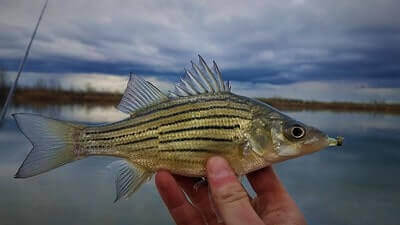
Table of Contents
How To Catch Yellow Bass
Yellow bass can be found in quiet pools and the backwaters of lakes, rivers, streams, and reservoirs. Anglers use many fishing methods such as baitcasting, trolling, still fishing, drift fishing, fly fishing, and spinning.
1. Baitcasting
Baitcasting artificial lures is an exciting and effective method for catching yellow bass, offering anglers the opportunity to cover a large area of water and target active fish. Anglers can use a variety of lures such as small crankbaits, spinners, and spoons to mimic the movement and appearance of yellow bass prey.
By casting these lures near shoreline structures, rocky points, or submerged vegetation where yellow bass are likely to be found, anglers can elicit strikes from feeding fish. Varying the retrieval speed, depth, and presentation of the lures can help determine the most effective approach to catching yellow bass.
Anglers should also pay attention to water temperature, weather conditions, and time of day to optimize their casting efforts. For more information on casting techniques and regulations for yellow bass fishing, anglers can consult resources provided by the state fish and wildlife agency, such as the U.S. Fish and Wildlife Service.
2. Drift Fishing
Drift fishing is a versatile and effective technique for catching yellow bass, particularly when targeting fish in open water or along expansive flats. Anglers can drift along wind or current-driven currents while presenting baits or lures naturally to entice yellow bass.
Common baits used for drift fishing include live minnows, worms, or cut bait, which can be rigged on hooks and allowed to drift naturally with the current. Additionally, anglers can use drifting techniques with artificial lures such as soft plastics or jigs, adjusting the weight and presentation to match the prevailing conditions and water depth.
Drift fishing allows anglers to cover a large area of water efficiently while targeting actively feeding yellow bass. For more information on drift fishing techniques and regulations for yellow bass fishing, anglers can consult resources provided by the state fish and wildlife agency, such as the U.S. Fish and Wildlife Service.
3. Trolling
Trolling is a popular and productive method for catching yellow bass, allowing anglers to cover a large area of water and present lures at various depths to target fish suspended at different levels. Anglers typically use small crankbaits, spinners, or trolling spoons rigged behind a moving boat, adjusting the trolling speed and depth to match the behavior and preferences of yellow bass.
By trolling along underwater structures such as drop-offs, channel edges, or submerged points where yellow bass congregate, anglers can effectively locate and catch these fish. Paying attention to sonar readings and using downriggers or planer boards can help anglers target yellow bass at specific depths and increase their chances of success.
For more information on trolling techniques and regulations for yellow bass fishing, anglers can refer to resources provided by the state fish and wildlife agency, such as the U.S. Fish and Wildlife Service.
4. Still Fishing
Still fishing, also known as bottom fishing, is a straightforward yet effective method for catching yellow bass, especially when targeting them in areas with submerged structures or along the bottom of lakes, ponds, or rivers. Anglers typically anchor their boats or position themselves on the shoreline near promising spots such as rocky outcrops, underwater ledges, or drop-offs where yellow bass are known to congregate.
Using a variety of bait options like live minnows, worms, or cut bait, anglers rig their lines with appropriate weights to ensure their bait remains near the bottom where yellow bass often feed. Patience is key when still fishing for yellow bass, as anglers may need to wait for the fish to locate and strike their bait.
Adjusting the depth of the bait and experimenting with different presentations can increase the likelihood of success. For more information on still fishing techniques and regulations for yellow bass fishing, anglers can consult resources provided by the state fish and wildlife agency, such as the U.S. Fish and Wildlife Service.
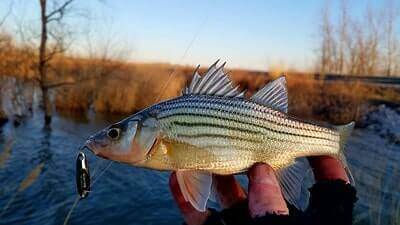
5. Fly Fishing
Fly fishing for yellow bass can be an exciting and rewarding experience, offering anglers the opportunity to use lightweight equipment and precise casting techniques to target these feisty fish. Anglers typically use lightweight fly rods, reels, and floating or sinking fly lines matched to the size of the flies and the depth of the water.
When targeting yellow bass, anglers often focus on shallow areas near shorelines, submerged structures, or along weed beds where these fish tend to congregate. Flies used for yellow bass fishing can vary depending on the angler’s preference and local conditions but often include small streamers, nymphs, or dry flies that mimic the natural prey of yellow bass, such as small baitfish, insects, or crustaceans.
Effective presentation techniques include casting near shoreline cover, retrieving the fly with short, erratic strips, or allowing the fly to drift naturally with the current. Anglers may also experiment with different retrieve speeds and depths to entice yellow bass to strike. For more information on fly fishing techniques and regulations for yellow bass fishing, anglers can consult resources provided by the state fish and wildlife agency, such as the U.S. Fish and Wildlife Service.
6. Spinning
Spinning is a popular and effective fishing method for targeting yellow bass, offering anglers versatility and ease of use. When fishing for yellow bass with spinning gear, anglers typically use lightweight spinning rods and reels paired with monofilament or braided fishing lines.
The versatility of spinning gear allows anglers to cast a wide range of lures and baits to cover various water depths and structures where yellow bass is commonly found. Common lures for yellow bass fishing include small spinners, crankbaits, jigs, and soft plastics that mimic the natural prey of yellow bass, such as small baitfish and insects.
Anglers often target shallow areas near shorelines, docks, submerged vegetation, or underwater structures where yellow bass congregate to feed. Effective presentation techniques include casting lures near cover, retrieving them with a steady or erratic retrieve, or using a jigging motion to entice strikes. Anglers may also experiment with different colors, sizes, and retrieves to determine what triggers a bite from yellow bass in their area.
For more information on spinning techniques and regulations for yellow bass fishing, anglers can consult resources provided by the state fish and wildlife agency, such as the U.S. Fish and Wildlife Service.
7. Jigging
Jigging is a popular technique for targeting yellow bass, offering anglers a versatile and effective method to entice these freshwater fish. Anglers typically use small jigs, often tipped with bait such as worms or minnows, to mimic the natural prey of yellow bass.
By vertically jigging these lures near underwater structure such as rocks, submerged trees, or drop-offs where yellow bass congregate, anglers can elicit strikes from these aggressive feeders. Varying the speed and cadence of the jigging motion can help determine the most effective presentation to trigger bites from yellow bass.
To learn more about jigging techniques and regulations for yellow bass fishing, anglers can consult resources provided by the state fish and wildlife agency, such as the U.S. Fish and Wildlife Service.
8. Live Bait Fishing
Live bait fishing is a classic and productive method for catching yellow bass, allowing anglers to present natural prey in a way that entices these fish to strike. Common live baits used for yellow bass fishing include minnows, worms, and small crayfish, which can be rigged on hooks and presented either below a bobber or on a Carolina rig to keep the bait near the bottom where yellow bass often feed.
Anglers can target areas with submerged structures, such as brush piles, weed beds, or drop-offs, where yellow bass are likely to congregate. Patience and attention to detail in presenting the live bait can lead to success when targeting yellow bass. For more information on live bait fishing techniques and regulations for yellow bass, anglers can refer to resources provided by the state fish and wildlife agency, such as the U.S. Fish and Wildlife Service.
Yellow Bass Fishing Tackle
Yellow bass, like its cousin white bass, does not grow into large fish. You can use light to medium tackle when fishing. A light-weight to medium-weight action rod, preferably 6 to 7 foot with 4 to 6 pound test, will work when fishing for yellow bass. Moreover, lighter weight lines make it easier to cast the line further into the water.
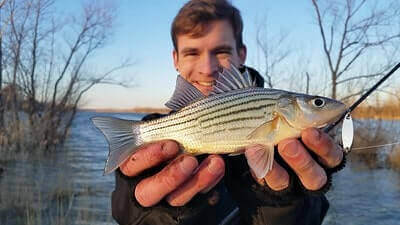
Best Baits For Yellow Bass
- Live Bait
Using live bait is a highly effective method for catching yellow bass, offering anglers the opportunity to present natural and enticing prey to these fish. Common live baits used for yellow bass fishing include minnows, worms, and insects such as crickets or grasshoppers.
Anglers can rig live bait using simple techniques such as hooking the bait through the lips or threading it onto a hook to ensure natural presentation and movement in the water. When targeting yellow bass with live bait, anglers often fish near submerged structures, underwater vegetation, or drop-offs where yellow bass are known to congregate.
Patience and finesse are key when fishing with live bait, as anglers must carefully present the bait in areas where yellow bass are likely to be feeding. Additionally, using a sensitive rod and reel setup allows anglers to detect subtle bites and make quick hook sets when a fish strikes.
Regulations regarding the use of live bait for yellow bass fishing may vary by location, so anglers should consult resources provided by their state fish and wildlife agency, such as the U.S. Fish and Wildlife Service, for specific guidelines and regulations.
2. Minnows
Minnows are among the most popular and effective baits for catching yellow bass. Anglers often use live minnows, such as fathead minnows or shiners, to entice these fish. Rigging a minnow for yellow bass fishing involves hooking the minnow through the lips or back, allowing it to swim naturally in the water and attract the attention of nearby fish.
When fishing for yellow bass with minnows, anglers typically target areas with submerged structures, drop-offs, or weed beds where these fish are known to congregate. It’s essential to adjust the size of the hook to match the size of the minnow and to use a sensitive rod and reel setup to detect subtle bites.
Additionally, anglers may choose to add weight to their line to keep the bait at the desired depth. Regulations regarding the use of minnows for yellow bass fishing may vary by location, so anglers should consult resources provided by their state fish and wildlife agency, such as the U.S. Fish and Wildlife Service, for specific guidelines and regulations.
3. Worms
Worms are a classic and effective bait choice for catching yellow bass. Anglers commonly use live worms like nightcrawlers or red wigglers to entice these fish. To rig a worm for yellow bass fishing, anglers typically thread the worm onto a small hook, leaving a portion of it dangling to attract fish. Yellow bass are known to be opportunistic feeders, so presenting a wriggling worm in their vicinity can often elicit strikes.
When fishing with worms for yellow bass, anglers often target areas with submerged structures, rocky outcrops, or drop-offs where these fish are likely to gather. It’s crucial to use a sensitive rod and reel setup to detect subtle bites, as yellow bass may sometimes take the bait lightly. Additionally, anglers may choose to add weights to their line to keep the bait at the desired depth.
Anglers should familiarize themselves with local fishing regulations regarding the use of worms as bait for yellow bass, as rules may vary by location. Resources provided by state fish and wildlife agencies, such as the U.S. Fish and Wildlife Service, offer valuable information on fishing regulations and guidelines specific to each region.
4. Spikes
Spikes, also known as maggots or larvae of various insects, are an effective bait choice for targeting yellow bass. These small, wriggling creatures are enticing to yellow bass, which are known to feed on a variety of small organisms. Anglers often use spikes in conjunction with other baits or as a standalone option on small hooks.
To fish with spikes for yellow bass, anglers typically thread several larvae onto a hook, ensuring they are secure but still able to move naturally in the water. This presentation mimics the appearance of natural prey and can attract the attention of yellow bass. Anglers commonly fish with spikes in areas with vegetation, submerged structures, or drop-offs where yellow bass are known to congregate. As with other live baits, it’s essential to use a sensitive rod and reel setup to detect subtle bites from yellow bass.
Additionally, anglers should check local fishing regulations regarding the use of spikes as bait and adhere to size and quantity limits if applicable. For more information on fishing regulations and guidelines specific to each region, anglers can consult resources provided by state fish and wildlife agencies, such as the U.S. Fish and Wildlife Service.
5. Wax Worms
Wax worms are a popular and effective bait choice for anglers targeting yellow bass. These soft-bodied larvae of the wax moth are readily available at bait shops and are prized for their lively movement in the water, which can attract the attention of hungry yellow bass. Anglers typically rig wax worms on small hooks, either singly or in clusters, to create an enticing presentation.
When fishing for yellow bass with wax worms, it’s essential to use light tackle and sensitive equipment to detect subtle strikes. Anglers often fish wax worms near submerged structures, weed beds, or drop-offs where yellow bass are known to congregate. It’s also important to adjust the depth of the bait to match the location of the fish, as yellow bass may be found at various depths depending on factors such as water temperature and time of day.
As with other live baits, anglers should be mindful of local fishing regulations regarding the use of wax worms and adhere to size and quantity limits if applicable. For comprehensive information on fishing regulations and guidelines specific to each region, anglers can refer to resources provided by state fish and wildlife agencies, such as the U.S. Fish and Wildlife Service.
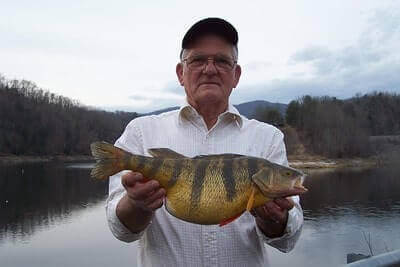
Best Lures For Yellow Bass
- Jigs
Jigs are highly effective lures for targeting yellow bass, offering versatility and adaptability to various fishing conditions. These small, weighted hooks adorned with colorful skirts or soft plastic bodies mimic the appearance of natural prey, making them irresistible to yellow bass. Anglers can employ a variety of jigging techniques to entice strikes from yellow bass, including vertical jigging, casting and retrieving, and bouncing the jig off the bottom.
When using jigs to catch yellow bass, it’s crucial to select the appropriate size and color based on water clarity, light conditions, and the forage species present in the area. Yellow bass is known to inhabit a range of aquatic environments, including lakes, rivers, and reservoirs, so anglers should target areas with submerged structures, drop-offs, or weed beds where yellow bass are likely to congregate.
Additionally, anglers can experiment with different jigging speeds and retrieve patterns to determine the most effective presentation for enticing yellow bass strikes. As with any fishing activity, anglers should familiarize themselves with local fishing regulations and guidelines to ensure compliance with size and quantity limits for yellow bass.
For comprehensive information on fishing regulations and guidelines specific to each region, anglers can refer to resources provided by state fish and wildlife agencies, such as the U.S. Fish and Wildlife Service.
2. Inline Spinners
Inline spinners are effective lures for targeting yellow bass, offering a combination of flash, vibration, and lifelike movement to entice strikes. These lures consist of a straight wire with a rotating blade and a small body adorned with colorful patterns or reflective surfaces.
When retrieved through the water, the spinning blade creates visual and acoustic cues that mimic the movement of small baitfish or insects, making them irresistible to yellow bass. Anglers can vary the retrieval speed and depth to adjust the presentation and attract fish in different water conditions. Inline spinners are particularly effective when fishing in shallow water or around submerged vegetation where yellow bass tend to congregate.
To maximize success when using inline spinners for yellow bass fishing, anglers should target areas with moderate current flow, such as river mouths, riffles, or eddies, where yellow bass are actively feeding. Additionally, anglers can experiment with different blade sizes, colors, and patterns to determine the most effective lure for enticing strikes.
As with any fishing activity, anglers should adhere to local fishing regulations and guidelines to ensure sustainable fishing practices. For comprehensive information on fishing regulations and guidelines specific to each region, anglers can refer to resources provided by state fish and wildlife agencies, such as the U.S. Fish and Wildlife Service.
3. Jigging Spoons
Jigging spoons are versatile lures that can be highly effective for catching yellow bass in various water conditions. These lures typically consist of a thin, metal spoon-shaped body with a single or treble hook attached at one end. When jigged vertically or cast and retrieved, jigging spoons create an enticing fluttering action that mimics the erratic movement of injured baitfish, attracting the attention of yellow bass.
Anglers can adjust the action of the spoon by varying the speed and rhythm of their jigging motion, allowing them to effectively target yellow bass at different depths and locations within the water column. In deeper waters, anglers can vertically jig spoons near structures such as submerged brush piles, rock formations, or drop-offs where yellow bass often congregate.
When fishing in shallower areas, casting and retrieving jigging spoons along weed lines, points, or other underwater structures can also yield success. Experimenting with different sizes, colors, and retrieves can help anglers determine the most effective presentation for enticing yellow bass.
To ensure sustainable fishing practices and compliance with regulations, anglers should always consult local fishing guidelines provided by authoritative sources such as the U.S. Fish and Wildlife Service. These resources offer valuable information on fishing regulations, bag limits, and conservation measures tailored to specific regions, helping anglers make informed decisions while enjoying their fishing pursuits.
4. Soft Plastics
Soft plastics are popular and effective lures for targeting yellow bass, offering anglers versatility and a lifelike presentation. These lures come in various shapes, sizes, and colors, including grubs, worms, swimbaits, and tubes, allowing anglers to match the hatch or experiment with different profiles to entice yellow bass.
Rigging soft plastics with jig heads or weighted hooks enables anglers to fish them at different depths and structures, such as weed beds, drop-offs, or rocky bottoms, where yellow bass are commonly found. The soft, supple material of these lures provides a natural feel and movement in the water, mimicking the appearance of live baitfish or invertebrates, which can trigger aggressive strikes from yellow bass.
Anglers can employ a variety of retrieval techniques, including steady retrieves, hops, twitches, and pauses, to impart lifelike action to the soft plastic and entice yellow bass into striking. Additionally, scent-impregnated or flavored soft plastics can further enhance their effectiveness, especially in situations where visibility is low or fish are more finicky.
By experimenting with different soft plastic styles, colors, and presentations, anglers can tailor their approach to match the preferences of yellow bass in their local waters. For comprehensive information on fishing regulations, conservation efforts, and best practices, anglers should refer to authoritative sources such as the U.S. Fish and Wildlife Service, which provides valuable resources to help anglers make informed decisions and contribute to sustainable fisheries management.
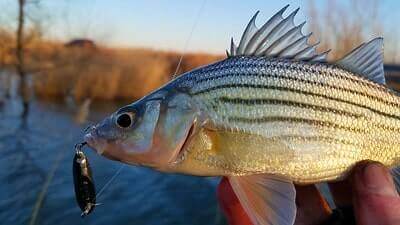
How To Catch Yellow Bass Ice Fishing
When ice fishing for yellow bass, drill as many holes as you can to increase your chances of finding and catching them. Moreover, use your ice fishing fish finder to locate schools of yellow fish. If you see fish and they won’t bite, you can use this trick to determine if they are yellow bass or another species of fish.
Drop a small spoon down and move it through the school of fish. If they all scatter, then they were perch. If they linger around, they are most likely yellow bass.
Small spoons and jigs with spikes or wax worms at the tip are some of the lures that are effective when ice fishing for yellow bass. A light action rod and a reel that is spooled with a fluorocarbon-coated ice line will work.
How To Catch Yellow Bass In The Night
Yellow bass is most active at night and in low-light conditions like early morning and late evening. When fishing for yellow bass during the night, lures such as spoons and spinners with a silver shine work well. Minnows and jigs are also very effective when fishing for yellow bass. Baits and insects that resemble insects, small shad, insect larvae, small Sunfish, and minnows work well.
When night fishing, look for yellow bass near bridges, docks, piers, creeks, and river channels. They can also be found in drop-off areas. A rig that proves to be very effective when fishing for yellow bass during the night is a lighted slip-bobber rig.
Yellow Bass Fishing Tips
- Yellowbass is often found at the bottom preying on blood worms and other baitfish.
2. Keep your bait within six inches of the bottom.
3. Yellow bass spawns in May when the water temperature is between 60 and 65 degrees.
4. Yellow bass is usually found in 6 to 12 feet of water during the winter.

5. Yellow bass are most active during low-light conditions early in the morning and late evening.
6. Yellow bass spawns in two to three feet of water. When fishing for them during the spawning season, look for rocky shorelines or shallow rock reefs.
7. The best time of the year to catch yellow bass is summer and spring.
8. Drift fishing, trolling, baitcasting, fly fishing, and still fishing are some of the fishing methods that can be used when fishing for yellow bass.
9. When ice fishing for yellow bass, drill many holes to increase your chances of finding them.
10. When yellow bass ice fishing, use your ice fishing fish finder to locate fish. if you don’t see them in one area, move to another area. if you are interested in ice fishing fish finders, then read the best ice fishing fish finders.
The Bottom Line
Yellow bass is very similar to white bass, except for the yellow sides and black stripes. It can be found in the Northeast, Midwest, and Southern parts of the United States.
Additionally, they can be found in quiet pools and the backwaters of reservoirs, streams, rivers, and lakes. In this article, we discussed how to catch yellow bass, the fishing methods, the baits and lures, and fishing tackle, and shared some tips and tricks to catch more yellow bass. You can also read how to catch smallmouth bass, how to catch spotted bass, how to catch largemouth bass, and how to catch black sea bass.